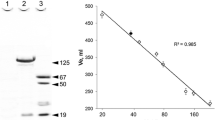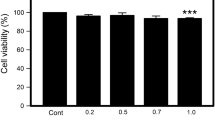Abstract
Copper-containing plasma protein ceruloplasmin (Cp) forms a complex with lactoferrin (Lf), an iron-binding protein, and with the heme-containing myeloperoxidase (Mpo). In case of inflammation, Lf and Mpo are secreted from neutrophil granules. Among the plasma proteins, Cp seems to be the preferential partner of Lf and Mpo. After an intraperitoneal injection of Lf to rodents, the “Cp–Lf” complex has been shown to appear in their bloodstream. Cp prevents the interaction of Lf with protoplasts of Micrococcus luteus. Upon immunoprecipitation of Cp, the blood plasma becomes depleted of Lf and in a dose-dependent manner loses the capacity to inhibit the peroxidase activity of Mpo, but not the Mpo-catalyzed oxidation of thiocyanate in the (pseudo)halogenating cycle. Antimicrobial effect against E. coli displayed by a synergistic system that includes Lf and Mpo–H2O2–chloride, but not thiocyanate, as the substrate for Mpo is abrogated when Cp is added. Hence, Cp can be regarded as an anti-inflammatory factor that restrains the halogenating cycle and redirects the synergistic system Mpo–H2O2–chloride/thiocyanate to production of hypothiocyanate, which is relatively harmless for the human organism. Structure and functions of the “2Cp–2Lf–Mpo” complex and binary complexes Cp–Lf and 2Cp–Mpo in inflammation are discussed.






Similar content being viewed by others

Abbreviations
- Cp:
-
Ceruloplasmin
- Lf:
-
Lactoferrin
- Mpo:
-
Myeloperoxidase
References
Anderson NL, Nance SL, Pearson TW et al (1982) Specific antiserum staining of two-dimensional electrophoretic patterns of human plasma proteins immobilized on nitrocellulose. Electrophoresis 3:135–142
Bakkenist AR, Wever R, Vulsma T et al (1978) Isolation procedure and some properties of myeloperoxidase from human leucocytes. Biochim Biophys Acta 524:45–54
Beers RF Jr, Sizer IW (1952) A spectrophotometric method for measuring the breakdown of hydrogen peroxide by catalase. J Biol Chem 195:133–140
Blair-Johnson M, Fiedler T, Fenna R (2001) Human myeloperoxidase: structure of a cyanide complex and its interaction with bromide and thiocyanate substrates at 1.9 Å resolution. Biochemistry 4:13990–13997
Borisova AV, Karyakina EE, Cosnier S et al (2009) Current-free deposition of Prussian blue with organic polymers: towards improved stability and mass production of the advanced hydrogen peroxide transducer. Electroanalysis 21:409–414
Chandler JD, Day BJ (2012) Thiocyanate: a potentially useful therapeutic agent with host defense and antioxidant properties. Biochem Pharmacol 84:1381–1387
Chapman AL, Mocatta TJ, Shiva S et al (2013) Ceruloplasmin is an endogenous inhibitor of myeloperoxidase. J Biol Chem 288:6465–6477
Cooper RA (2013) Inhibition of biofilms by glucose oxidase, lactoperoxidase and guaiacol: the active antibacterial component in an enzyme alginogel. Int Wound J 10:630–637
Davis BJ (1964) Disc electrophoresis. II. Method and application to human serum proteins. Ann N Y Acad Sci 121:404–427
Delporte C, Zouaoui Boudjeltia K, Noyon C et al (2014) Impact of interaction between myeloperoxidase and low-density lipoprotein on the specific activity of the enzyme and subsequent post-translational oxidative modifications of apolipoprotein B-100. J Lipid Res 55:747–757
Edeleva NV, Sergeeva TV, Nemtsova ER et al (2001) Antioxidants ceruloplasmin and lactoferrin in the prevention and treatment of postoperative complications in cancer patients. Anesteziol Reanimatol 5:61–64
Gitlin JD (1988) Transcriptional regulation of ceruloplasmin gene expression during inflammation. J Biol Chem 263:6281–6287
Glezer I, Chernomoretz A, David S et al (2007) Genes involved in the balance between neuronal survival and death during inflammation. PLoS ONE 2:e310
Griffin SV, Chapman PT, Lianos EA et al (1999) The inhibition of myeloperoxidase by ceruloplasmin can be reversed by anti-myeloperoxidase antibodies. Kidney Int 55:917–925
Ha-Doong NT, Eid C, Hemadi M et al (2010) In vitro interaction between ceruloplasmin and human serum transferring. Biochemistry 49:10261–10263
Kim IG, Park SY (1998) Requirement of intact human ceruloplasmin for the glutathione-linked peroxidase activity. FEBS Lett 437:293–296
Kokryakov VN (1999) Biology of antibiotics of animal origin [in Russian]. Nauka, St. Petersburg
Laemmli UK (1970) Cleavage of structural proteins during the assembly of the head of bacteriophage T4. Nature 227:680–685
Lampreave F, Piñeiro A, Brock JH et al (1990) Interaction of bovine lactoferrin with other proteins of milk whey. Int J Biol Macromol 12:2–5
Lehrer RI, Cline MJ (1969) Leukocyte myeloperoxidase deficiency and disseminated candidiasis: the role of myeloperoxidase in resistance to Candida infection. J Clin Invest 48(8):1478–1488
Marques L, Auriac A, Willemetz A et al (2012) Immune cells and hepatocytes express glycosylphosphatidylinositol-anchored ceruloplasmin at their cell surface. Blood Cells Mol Dis 48(2):110–120
Martin F, Linden T, Katschinski DM et al (2005) Copper-dependent activation of hypoxia-inducible factor (HIF)-1: implications for ceruloplasmin regulation. Blood 105:4613–4619
Mazumder B, Mukhopadhyay CK, Prok A et al (1997) Induction of ceruloplasmin synthesis by IFN-gamma in human monocytic cells. J Immunol 159:1938–1944
Mukhopadhyay CK, Mazumder B, Fox PL (2000) Role of hypoxia-inducible factor-1 in transcriptional activation of ceruloplasmin by iron deficiency. J Biol Chem 275:21048–21054
Nakamura M, Tomita A, Nakatani H et al (2006) Antioxidant and antibacterial genes are upregulated in early involution of the mouse mammary gland: sharp increase of ceruloplasmin and lactoferrin in accumulating breast milk. DNA Cell Biol 25:491–500
Noyer M, Dwulet FE, Hao YL et al (1980) Purification and characterization of undegraded human ceruloplasmin. Anal Biochem 102:450–458
Osaki S (1966) Kinetic studies of ferrous ion oxidation with crystalline human ferroxidase (ceruloplasmin). J Biol Chem 241:5053–5059
Panasenko OM, Gorudko IV, Sokolov AV (2013) Hypochlorous Acid as a precursor of free radicals in living systems. Biochemistry (Mosc) 78:1466–1489
Panasenko OM, Chekanov AV, Vlasova II et al (2008) A study of the effect of ceruloplasmin and lactoferrin on the chlorination activity of leukocytic myeloperoxidase using the chemiluminescence method. Biofizika 53:573–581
Park YS, Suzuki K, Mumby S et al (2000) Antioxidant binding of ceruloplasmin to myeloperoxidase: myeloperoxidase is inhibited, but oxidase, peroxidase and immunoreactive properties of ceruloplasmin remain intact. Free Radic Res 33:261–265
Perraudin JP, Prieels JP (1982) Lactoferrin binding with lysozyme-treated Micrococcus luteus. Biochim Biophys Acta 718:42–48
Pulina MO, Zakharova ET, Sokolov AV et al (2002) Studies of the ceruloplasmin-lactoferrin complex. Biochem Cell Biol 80:35–39
Pulina MO, Sokolov AV, Zakharova ET et al (2010) Effect of lactoferrin on consequences of acute experimental hemorrhagic anemia in rats. Bull Exp Biol Med 149:219–222
Sabatucci A, Vachette P, Vasilyev VB et al (2007) Structural characterization of the ceruloplasmin: lactoferrin complex in solution. J Mol Biol 371:1038–1046
Salzer JL, Lovejoy L, Linder MC et al (1998) Ran-2, a glial lineage marker, is a GPI-anchored form of ceruloplasmin. J Neurosci Res 54:147–157
Samygina VR, Sokolov AV, Pulina MO et al (2008) X-ray diffraction study of highly purified human ceruloplasmin. Crystallogr Rep 53:655–662
Samygina VR, Sokolov AV, Bourenkov G et al (2013) Ceruloplasmin: macromolecular assemblies with iron-containing acute phase proteins. PLoS ONE 8:e67145
Segelmark M, Persson B, Hellmark T et al (1997) Binding and inhibition of myeloperoxidase (MPO): a major function of ceruloplasmin? Clin Exp Immunol 108:167–174
Seshadri V, Fox PL, Mukhopadhyay CK (2002) Dual role of insulin in transcriptional regulation of the acute phase reactant ceruloplasmin. J Biol Chem 277:27903–27911
Sharonov BP, Govorova NJu, Lyzlova SN (1988) A comparative study of serum proteins ability to scavenge active oxygen species: O2-. and OCl-. Biochem Int 17:783–790
Sharonov BP, Govorova NJu, Lyzlova SN (1989) Serum protein degradation by hypochlorite. Biochem Int 19:27–35
Shiva S, Wang X, Ringwood LA et al (2006) Ceruloplasmin is a NO oxidase and nitrite synthase that determines endocrine NO homeostasis. Nat Chem Biol 2:486–493
Sokolov AV, Pulina MO, Zakharova ET et al (2005a) Effect of lactoferrin on the ferroxidase activity of ceruloplasmin. Biochem (Mosc) 70:1015–1019
Sokolov AV, Zakharova ET, Shavlovskiĭ MM et al (2005b) Isolation of stable human ceruloplasmin and its interaction with salmon protamine. Bioorg Khim 31:269–279
Sokolov AV, Pulina MO, Zakharova ET et al (2006) Identification and isolation from breast milk of ceruloplasmin-lactoferrin complex. Biochem (Mosc) 71:160–166
Sokolov AV, Pulina MO, Ageeva KV et al (2007a) Interaction of ceruloplasmin, lactoferrin, and myeloperoxidase. Biochem (Mosc) 72:409–415
Sokolov AV, Pulina MO, Ageeva KV et al (2007b) Identification of leukocyte cationic proteins that interact with ceruloplasmin. Biochem (Mosc) 72:872–877
Sokolov AV, Ageeva KV, Pulina MO et al (2008) Ceruloplasmin and myeloperoxidase in complex affect the enzymatic properties of each other. Free Radic Res 42:989–998
Sokolov AV, Ageeva KV, Pulina MO et al (2009a) b Effect of lactoferrin on oxidative features of ceruloplasmin. Biometals 22:521–529
Sokolov AV, Pulina MO, Ageeva KV et al (2009b) Identification of complexes formed by ceruloplasmin with matrix metalloproteinases 2 and 12. Biochem (Mosc) 74:1388–1392
Sokolov AV, Prozorovski VN, Vasilyev VB (2009c) Study of interaction of ceruloplasmin, lactoferrin and myeloperoxidase by photon correlation spectroscopy. Biochem (Mosc) 74:1225–1227
Sokolov AV, Ageeva KV, Cherkalina OS et al (2010a) c Identification and properties of complexes formed by myeloperoxidase with lipoproteins and ceruloplasmin. Chem Phys Lipids 163:347–355
Sokolov AV, Golenkina EA, Kostevich VA et al (2010b) a Interaction of ceruloplasmin and 5-lipoxygenase. Biochem (Mosc) 75:1464–1469
Sokolov AV, Ageeva KV, Kostevich VA et al (2010c) Study of interaction of ceruloplasmin with serprocidins. Biochem (Mosc) 75:1361–1367
Sokolov AV, Kostevich VA, Romanico DN et al (2012a) b Two-stage method for purification of ceruloplasmin based on its interaction with neomycin. Biochem (Mosc) 77:631–638
Sokolov AV, Solovyov KV, Kostevich VA et al (2012b) Protection of ceruloplasmin by lactoferrin against hydroxyl radicals is pH dependent. Biochem Cell Biol 90:397–404
Sokolov AV, Pulina MO, Runova OL et al (2013) Complex of ceruloplasmin and lactoferrin in human lacrimal fluid. Med Acad J (Russ) 13:39–43
Sokolov AV, Kostevich VA, Runova OL et al (2014) Proatherogenic modification of LDL by surface-bound myeloperoxidase. Chem Phys Lipid 180:72–80
Stoj C, Kosman DJ (2003) Cuprous oxidase activity of yeast Fet3p and human ceruloplasmin: implication for function. FEBS Lett 554:422–426
Sun XL, Baker HM, Shewry SC et al (1999) Structure of recombinant human lactoferrin expressed in Aspergillus awamori. Acta Crystallogr D Biol Crystallogr 55:403–407
Tenovuo J (2002) Clinical applications of antimicrobial host proteins lactoperoxidase, lysozyme and lactoferrin in xerostomia: efficacy and safety. Oral Dis 8:23–29
Tiruppathi C, Naqvi T, Wu Y et al (2004) Albumin mediates the transcytosis of myeloperoxidase by means of caveolae in endothelial cells. Proc Natl Acad Sci U S A 101:7699–7704
van Dalen CJ, Whitehouse MW, Winterbourn CC et al (1997) Thiocyanate and chloride as competing substrates for myeloperoxidase. Biochem J 327:487–492
van der Does AM, Hensbergen PJ, Bogaards SJ et al (2012) The human lactoferrin-derived peptide hLF1-11 exerts immunomodulatory effects by specific inhibition of myeloperoxidase activity. J Immunol 188:5012–5019
Vasilyev VB, Kachurin AM, Soroka NV (1988) Dismutation of superoxide radicals by ceruloplasmin–details of the mechanism. Biokhimiya 53:2051–2058
Vassiliev V, Harris ZL, Zatta P (2005) Ceruloplasmin in neurodegenerative diseases. Brain Res Brain Res Rev 49:633–640
Vlasova II, Sokolov AV, Arnhold J (2012) The free amino acid tyrosine enhances the chlorinating activity of human myeloperoxidase. J Inorg Biochem 106:76–83
Voronina OV, Monakhov NK (1980) Estradiol-induced formation of the polyribosomal complex synthesizing ceruloplasmin in rats. Biokhimiia 45:1010–1016
White KN, Conesa C, Sánchez L et al (2012) The transfer of iron between ceruloplasmin and transferrins. Biochim Biophys Acta 1820:411–416
Xu PC, Chen M, Zhao MH (2012) High potential to reverse the inhibition of myeloperoxidase by ceruloplasmin of anti-myeloperoxidase autoantibodies of IgG3 subclass. Autoimmunity 45:218–225
Xu PC, Li ZY, Yang XW et al (2013) Myeloperoxidase influences the complement regulatory function of modified C-reactive protein. Innate Immun 20:440–448
Yang S, Hua Y, Nakamura T et al (2006) Up-regulation of brain ceruloplasmin in thrombin preconditioning. Acta Neurochir Suppl 96:203–206
Zakharova ET, Shavlovski MM, Bass MG et al (2000) Interaction of lactoferrin with ceruloplasmin. Arch Biochem Biophys 374:222–228
Zakharova ET, Kostevich VA, Sokolov AV et al (2012) Human apo-lactoferrin as a physiological mimetic of hypoxia stabilizes hypoxia-inducible factor-1 alpha. Biometals 25:1247–1259
Acknowledgments
This study was supported by RFBR grants № 12-04-00301; 13-04-01191, MK-6062.2014.4 and by the Program “Human Proteome”. The authors are grateful to Professor V. N. Kokryakov for generously providing leukocytes of healthy donors, to Dr. M. N. Berlov for kind assistance in mastering the evaluation of antimicrobial activity of proteins, to Dr. M. O. Pulina and Dr. A. N. Skvortsov for CD-spectra measurement.
Author information
Authors and Affiliations
Corresponding author
Rights and permissions
About this article
Cite this article
Sokolov, A.V., Zakahrova, E.T., Kostevich, V.A. et al. Lactoferrin, myeloperoxidase, and ceruloplasmin: complementary gearwheels cranking physiological and pathological processes. Biometals 27, 815–828 (2014). https://doi.org/10.1007/s10534-014-9755-2
Received:
Accepted:
Published:
Issue Date:
DOI: https://doi.org/10.1007/s10534-014-9755-2



